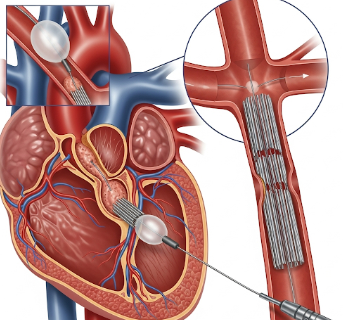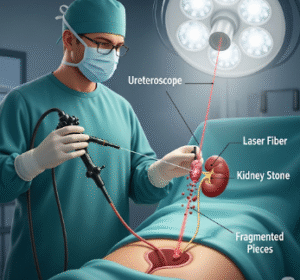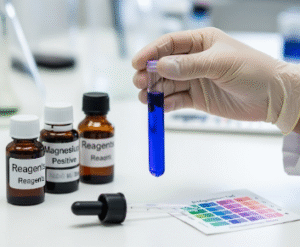Overview
Coronary angioplasty, also called percutaneous coronary intervention (PCI), is a minimally invasive procedure used to open narrowed or blocked coronary arteries. A stent, a small mesh tube, is often inserted to keep the artery open and maintain blood flow to the heart muscle.
Importance of coronary angioplasty and stent insertion:
- Restores blood flow to the heart, relieving chest pain (angina) and improving heart function.
- Reduces the risk of heart attack in patients with blocked coronary arteries.
- Improves quality of life for patients with coronary artery disease.
- Can be life-saving in acute myocardial infarction (heart attack).
In South Korea, coronary angioplasty with stent placement is routinely performed in advanced cardiology centers using state-of-the-art imaging and stent technology, including drug-eluting stents for long-term vessel patency.
Why It’s Done
Coronary angioplasty and stent insertion are performed to treat coronary artery disease (CAD) and restore blood flow to the heart.
Common indications include:
- ➤ Acute myocardial infarction (heart attack) requiring emergency reperfusion.
- ➤ Stable angina not responding to medications.
- ➤ Unstable angina with high risk of progression to heart attack.
- ➤ Significant coronary artery narrowing identified on diagnostic angiography.
- ➤ Recurrent angina after prior heart procedures or bypass surgery.
Benefits for patients:
- ✔️ Relieves chest pain and improves exercise tolerance.
- ✔️ Prevents heart muscle damage during acute coronary events.
- ✔️ Reduces risk of heart failure and cardiovascular complications.
- ✔️ Short recovery period compared to open-heart surgery.
Alternatives
Depending on the patient’s condition, alternatives may include:
- ➤ Medical therapy: Anti-anginal medications (nitrates, beta-blockers, calcium channel blockers) and cholesterol-lowering drugs.
- ➤ Coronary artery bypass grafting (CABG): Surgical bypass for severe or multiple blockages.
- ➤ Lifestyle modifications: Smoking cessation, diet changes, exercise, and weight management.
- ➤ Balloon angioplasty without stent: Less common today due to higher restenosis rates.
Key point: Stent placement is preferred when long-term vessel patency and prevention of restenosis are priorities.
Preparation
Proper preparation ensures safe intervention, optimal outcomes, and minimal complications.
Steps include:
- ✅ Comprehensive cardiac evaluation: ECG, echocardiography, stress testing, and coronary angiography.
- ✅ Blood tests: Kidney function, coagulation profile, complete blood count.
- ✅ Medication review: Blood thinners, antiplatelet drugs, or other heart medications adjusted as necessary.
- ✅ Patient counseling: Explain procedure, benefits, risks, post-procedure care, and stent types.
- ✅ Fasting: Typically 6–8 hours before the procedure.
- ✅ Consent: Informed agreement covering procedure, alternatives, and potential complications.
Important: Pre-procedure assessment minimizes risk and ensures patient safety during angioplasty.
How It’s Done
Coronary angioplasty with stent insertion is a minimally invasive, catheter-based procedure performed in a cardiac catheterization lab.
Procedure steps:
- Local anesthesia: Usually in the groin (femoral artery) or wrist (radial artery).
- Catheter insertion: A thin catheter is threaded through the artery to the blocked coronary vessel under X-ray guidance.
- Balloon angioplasty: A small balloon at the catheter tip is inflated to widen the narrowed artery.
- Stent placement: A stent is deployed at the blockage site to maintain arterial patency.
- Balloon removal and closure: Catheter withdrawn; puncture site closed with manual pressure, closure device, or band.
- Post-procedure imaging: Angiography confirms successful artery opening.
Duration: Typically 30 minutes to 2 hours depending on complexity.
Hospital stay: Often 1–2 days for elective procedures; emergency cases may require longer observation.
Key point: Modern stents, including drug-eluting stents, reduce the risk of restenosis and improve long-term outcomes.
Recovery & Post-Use Care
Recovery after coronary angioplasty and stent insertion is rapid compared to open-heart surgery, but requires careful monitoring.
Immediate post-procedure care:
- Bed rest for 2–6 hours depending on access site.
- Monitor vital signs, puncture site, and heart rhythm.
- Antiplatelet therapy (aspirin, clopidogrel, or newer agents) to prevent stent thrombosis.
Short-term care:
- Avoid heavy lifting or strenuous activity for a few days.
- Maintain hydration and follow prescribed medications.
- Attend follow-up visits for angiogram or stress tests if recommended.
Long-term outcomes:
- Regular cardiac check-ups to monitor stent patency and heart function.
- Lifestyle modifications (diet, exercise, smoking cessation) to prevent further coronary disease.
- Most patients experience symptom relief and improved quality of life.
Important: Adherence to medications, especially dual antiplatelet therapy, is critical for preventing stent complications.
Possible Complications / Risks
While generally safe, coronary angioplasty with stent insertion carries potential risks:
- ⚠️ Bleeding or hematoma at catheter insertion site.
- ⚠️ Artery damage or dissection.
- ⚠️ Stent thrombosis: Blood clot within the stent; prevented by antiplatelet therapy.
- ⚠️ Restenosis: Re-narrowing of the treated artery.
- ⚠️ Heart attack or arrhythmias during or shortly after the procedure.
- ⚠️ Allergic reactions to contrast dye or medications.
- ⚠️ Kidney injury due to contrast dye, particularly in patients with pre-existing kidney disease.
In South Korea, procedures are performed in highly equipped cardiac centers, with strict protocols to minimize complications and monitor patient safety.
Treatment Options / Clinical Relevance in Korea
Coronary angioplasty with stent insertion is widely available in South Korea, performed in advanced cardiology centers with modern stents and imaging technologies.
Key features:
- 🏥 Available in hospitals such as Severance Hospital, Samsung Medical Center, and Asan Medical Center.
- 🏥 Emergency PCI is routinely performed for acute myocardial infarction.
- 🏥 Modern drug-eluting stents minimize restenosis.
- 🏥 Comprehensive cardiac care includes pre- and post-procedure assessment, rehabilitation, and follow-up.
- 🏥 Patient education emphasizes medication adherence, lifestyle modification, and cardiac risk management.
Highlights in Korea:
- ✔️ Advanced cardiac centers provide state-of-the-art stents and catheterization techniques.
- ✔️ High success rates for symptom relief and improved long-term outcomes.
- ✔️ Emergency PCI protocols improve survival in acute heart attacks.
- ✔️ Integrated cardiac rehabilitation supports long-term heart health.
Highlights
- ➤ Coronary angioplasty opens narrowed coronary arteries to restore blood flow.
- ➤ Stent insertion maintains arterial patency and reduces restenosis.
- ➤ Indicated for heart attack, unstable angina, and significant coronary narrowing.
- ➤ Alternatives include medical therapy, CABG, lifestyle changes, or balloon angioplasty alone.
- ➤ Preparation involves cardiac evaluation, blood tests, medication review, and informed consent.
- ➤ Procedure is minimally invasive, performed via catheter under local anesthesia.
- ➤ Recovery involves short hospitalization, antiplatelet therapy, and lifestyle modifications.
- ➤ South Korea offers advanced PCI with high-quality stents, skilled cardiologists, and comprehensive follow-up care.













